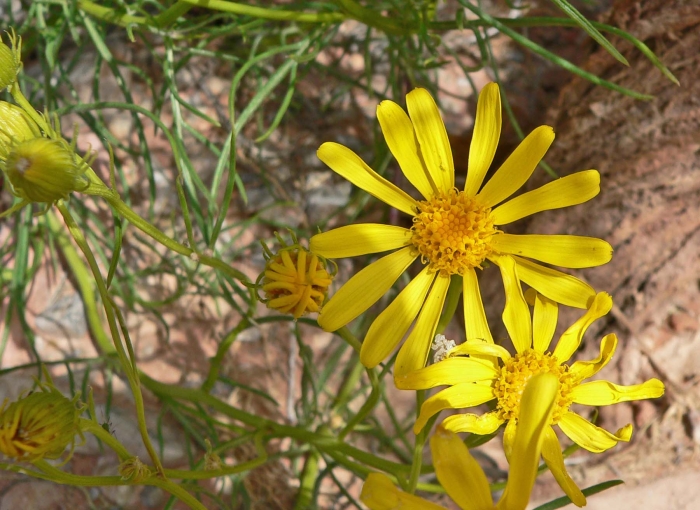Threadleaf Ragwort
(Senecio flaccidus)
Threadleaf Ragwort (Senecio flaccidus)
/
/

User:Stan Shebs
CC BY-SA 3.0
Image By:
User:Stan Shebs
Recorded By:
Copyright:
CC BY-SA 3.0
Copyright Notice:
Photo by: User:Stan Shebs | License Type: CC BY-SA 3.0 | License URL: https://creativecommons.org/licenses/by-sa/3.0 | Uploader: Stan Shebs | Publisher: Wikimedia Commons | Title: Senecio_flaccidus_2.jpg | Notes: |




















































Estimated Native Range
Summary
Senecio flaccidus, commonly known as Threadleaf ragwort, is a fast-growing, short-lived perennial shrub native to desert grasslands, arid plains, and rocky slopes in the southwestern United States, California, and northern Mexico. It typically grows to a height of 4 feet 6 inches (1.37 m) with a bushy habit. The plant is characterized by its white, threadlike, bent and matted, tomentose leaves, which give it its common name. Threadleaf ragwort produces showy heads of bright yellow ray flowers, each 3 to 4 inches (7.6 to 10 cm) across, with eight to thirteen sterile rays and purplish-brown disk florets that produce seeds. Flowering occurs from late spring to early fall, and the flowers are particularly attractive to pollinators such as bees and butterflies.
Threadleaf ragwort is valued for its drought tolerance and ability to thrive in challenging environments, making it suitable for xeriscaping and naturalistic plantings in arid regions. It is often used in rock gardens, as a border plant, or for erosion control on slopes. This plant prefers full sun to part shade and requires minimal water once established, making it an excellent choice for water-wise gardens. It grows best in well-drained soils and is adaptable to a range of soil types. Gardeners should be aware that Senecio flaccidus can spread rapidly through self-seeding and may become invasive in some areas. Additionally, all parts of the plant are toxic if ingested, so caution should be exercised if planting in areas accessible to pets or children.CC BY-SA 4.0
Threadleaf ragwort is valued for its drought tolerance and ability to thrive in challenging environments, making it suitable for xeriscaping and naturalistic plantings in arid regions. It is often used in rock gardens, as a border plant, or for erosion control on slopes. This plant prefers full sun to part shade and requires minimal water once established, making it an excellent choice for water-wise gardens. It grows best in well-drained soils and is adaptable to a range of soil types. Gardeners should be aware that Senecio flaccidus can spread rapidly through self-seeding and may become invasive in some areas. Additionally, all parts of the plant are toxic if ingested, so caution should be exercised if planting in areas accessible to pets or children.CC BY-SA 4.0
Plant Description
- Plant Type: Subshrub, Herb
- Height: 3-4 feet
- Width: 2-3 feet
- Growth Rate: Moderate
- Flower Color: Yellow
- Flowering Season: Fall, Summer
- Leaf Retention: Deciduous
Growth Requirements
- Sun: Full Sun, Part Shade
- Water: Low
- Drainage: Medium, Fast
Common Uses
Bee Garden, Butterfly Garden, Drought Tolerant, Erosion Control, Low Maintenance, Rabbit Resistant, Rock Garden, Showy Flowers
Natural Habitat
native to desert grasslands, arid plains, and rocky slopes in the southwestern United States, California, and northern Mexico
Other Names
Common Names:
Scientific Names: , Senecio flaccidus, Senecio longilobus, Senecio douglasii var. longilobus, Senecio filifolius, Senecio regiomontanus, Senecio douglasii subsp. longilobus, Senecio douglasii subsp. jamesii, Senecio filifolius var. jamesii,
GBIF Accepted Name: Senecio flaccidus Less.